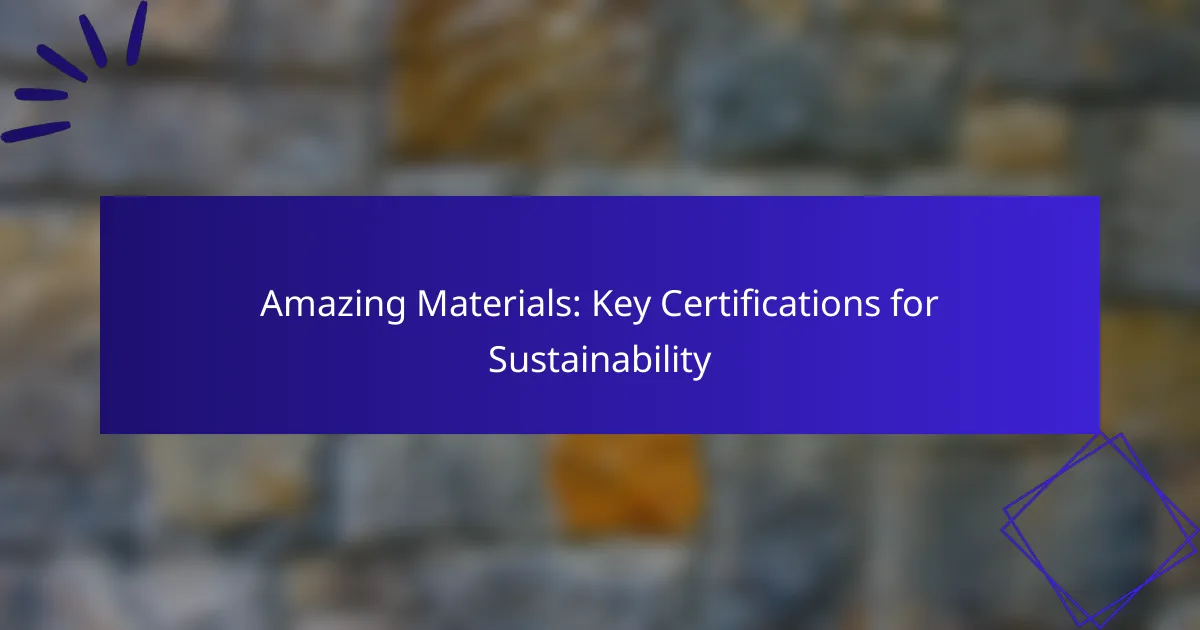Key certifications for sustainable materials play a vital role in ensuring that products adhere to specific environmental and social standards. By helping consumers identify eco-friendly options and encouraging manufacturers to adopt responsible practices, these certifications significantly influence material selection across various industries, including textiles, construction, and furniture.

What are the key certifications for sustainable materials?
Key certifications for sustainable materials indicate that products meet specific environmental and social standards. These certifications help consumers identify eco-friendly options and encourage manufacturers to adopt sustainable practices.
Global Organic Textile Standard (GOTS)
The Global Organic Textile Standard (GOTS) is a leading certification for organic textiles, ensuring that materials are made from at least 70% organic fibers. It covers the entire supply chain, from harvesting to manufacturing, and includes strict environmental and social criteria.
When choosing GOTS-certified products, look for labels that indicate compliance with both organic and ecological standards. This certification not only supports sustainable agriculture but also promotes fair labor practices in the textile industry.
Forest Stewardship Council (FSC)
The Forest Stewardship Council (FSC) certification ensures that wood and paper products come from responsibly managed forests. This certification promotes sustainable forestry practices that protect ecosystems and the rights of local communities.
When purchasing FSC-certified materials, check for the FSC logo, which signifies that the product meets rigorous environmental and social standards. This certification is crucial for reducing deforestation and promoting biodiversity.
LEED Certification
LEED (Leadership in Energy and Environmental Design) certification is a globally recognized standard for green building. It evaluates the environmental performance of buildings and encourages sustainable practices in design, construction, and operation.
To achieve LEED certification, projects must earn points across various categories, including energy efficiency, water usage, and materials selection. Consider LEED-certified buildings for their reduced environmental impact and improved occupant health.
Cradle to Cradle Certified
Cradle to Cradle Certified is a product standard that assesses materials based on their safety, circularity, and social fairness. This certification encourages the design of products that can be reused or recycled, minimizing waste and environmental impact.
When selecting Cradle to Cradle Certified products, look for different certification levels, which indicate the extent of sustainability achieved. This approach promotes a circular economy by ensuring that materials are continuously cycled back into production.
Energy Star Certification
Energy Star certification identifies energy-efficient products and buildings, helping consumers save on energy costs while reducing greenhouse gas emissions. This certification applies to a wide range of products, including appliances, electronics, and lighting.
When shopping for Energy Star-certified items, look for the Energy Star label, which indicates that the product meets strict energy efficiency guidelines set by the U.S. Environmental Protection Agency. Choosing these products can lead to significant energy savings over time.

How do certifications impact material selection?
Certifications significantly influence material selection by providing assurance of sustainability and ethical practices. They guide manufacturers and consumers in choosing materials that meet environmental and social standards, ultimately shaping purchasing decisions.
Enhances consumer trust
Certifications enhance consumer trust by verifying that materials meet specific sustainability criteria. When consumers see recognized labels, such as FSC for wood or GOTS for textiles, they feel more confident that their purchases align with their values.
For example, a product labeled with a credible certification is more likely to attract environmentally conscious buyers, leading to increased sales. This trust can also foster brand loyalty, as customers are more inclined to return to brands that prioritize sustainability.
Improves marketability
Having certified materials can significantly improve a product’s marketability. Certifications can serve as a unique selling proposition, distinguishing products in a crowded marketplace. Brands that highlight their sustainable practices often appeal to a growing demographic of eco-aware consumers.
For instance, products made from recycled materials or those that have undergone life cycle assessments often command higher prices. This premium can be justified by the perceived value of sustainability, making certified products more attractive to retailers and consumers alike.
Ensures compliance with regulations
Certifications help ensure compliance with various environmental regulations that may be in place. Many countries have specific laws governing the use of sustainable materials, and certifications can provide proof that a product meets these legal requirements.
For example, in the European Union, products may need to comply with REACH regulations concerning chemical safety. Certifications can simplify this process, as they often include assessments that align with regulatory standards, reducing the risk of non-compliance penalties.

Which industries benefit from sustainable materials certifications?
Sustainable materials certifications are crucial for various industries, helping them minimize environmental impact and enhance product credibility. Key sectors include textiles, construction, and furniture, where certified materials can lead to improved sustainability practices and consumer trust.
Textiles and Apparel
The textiles and apparel industry significantly benefits from sustainable materials certifications, as consumers increasingly demand eco-friendly products. Certifications like Global Organic Textile Standard (GOTS) and OEKO-TEX ensure that materials are produced with minimal environmental harm and safe for human use.
Brands should consider sourcing materials that are certified organic or recycled to appeal to environmentally conscious consumers. Additionally, transparency in the supply chain can enhance brand reputation and loyalty.
Construction and Architecture
In construction and architecture, sustainable materials certifications such as LEED (Leadership in Energy and Environmental Design) and BREEAM (Building Research Establishment Environmental Assessment Method) are vital. These certifications guide builders in selecting materials that reduce energy consumption and promote sustainability.
When planning a project, consider using certified materials like recycled steel or sustainably sourced wood. This not only meets regulatory standards but can also lead to cost savings through energy efficiency over time.
Furniture and Home Goods
The furniture and home goods sector is increasingly adopting sustainable materials certifications to meet consumer demand for eco-friendly products. Certifications like Forest Stewardship Council (FSC) ensure that wood products come from responsibly managed forests.
Manufacturers should prioritize using certified materials to differentiate their products in a competitive market. Additionally, providing clear information about the sustainability of materials can enhance consumer confidence and drive sales.

What are the prerequisites for obtaining sustainability certifications?
To obtain sustainability certifications, organizations must meet specific criteria that demonstrate their commitment to environmentally responsible practices. Key prerequisites include compliance with environmental standards, transparency in the supply chain, and regular audits to assess sustainability efforts.
Compliance with environmental standards
Compliance with environmental standards is crucial for sustainability certifications. Organizations must adhere to established regulations such as ISO 14001, which outlines effective environmental management systems. This compliance often involves implementing practices that minimize waste, reduce emissions, and conserve resources.
To ensure compliance, businesses should regularly review their operations against these standards and make necessary adjustments. Failure to meet these requirements can result in delays or denial of certification.
Documented supply chain transparency
Documented supply chain transparency is essential for sustainability certifications. Companies must provide clear documentation that traces the origin of materials and the practices of suppliers. This transparency helps verify that all components of a product meet sustainability criteria.
Organizations can achieve this by maintaining detailed records of sourcing practices and conducting supplier assessments. Engaging in partnerships with suppliers who prioritize sustainability can enhance credibility and facilitate the certification process.
Regular audits and assessments
Regular audits and assessments are necessary to maintain sustainability certifications. These evaluations help organizations identify areas for improvement and ensure ongoing compliance with sustainability standards. Audits can be conducted internally or by third-party assessors to provide an unbiased review.
Establishing a routine schedule for audits, such as annually or biannually, can help organizations stay on track with their sustainability goals. It’s important to address any findings promptly to avoid jeopardizing certification status.

How to choose the right certification for your materials?
Selecting the appropriate certification for your materials involves understanding the specific standards that align with your industry and consumer expectations. Focus on certifications that not only enhance your credibility but also resonate with your target market’s values.
Assess industry relevance
To choose the right certification, first evaluate its relevance within your industry. Different sectors may prioritize distinct certifications based on environmental impact, safety, or ethical sourcing. For example, textiles may emphasize organic certifications, while construction materials might focus on energy efficiency standards.
Research common certifications in your field, such as FSC for wood products or GOTS for organic textiles. Understanding which certifications are widely recognized can help you make informed decisions that enhance your marketability.
Evaluate consumer demand
Consumer demand plays a crucial role in certification selection. Analyze market trends and preferences to determine which certifications are most valued by your target audience. Certifications like Fair Trade or LEED can significantly influence purchasing decisions, especially among environmentally conscious consumers.
Conduct surveys or focus groups to gather insights on what certifications matter most to your customers. Aligning your materials with these demands can improve customer loyalty and boost sales.
Consider cost and resources
Cost and resource allocation are vital when selecting certifications. Some certifications may require extensive documentation, testing, or audits, which can be resource-intensive. Assess your budget and capabilities to ensure you can meet the certification requirements without compromising your operations.
Consider starting with certifications that have lower barriers to entry and gradually move to more complex ones as your business grows. This approach allows you to build credibility while managing costs effectively.

What are the emerging trends in sustainable materials certifications?
Emerging trends in sustainable materials certifications focus on enhancing environmental responsibility and promoting resource efficiency. These trends reflect a growing commitment to sustainability across industries, emphasizing practices that reduce waste and improve material lifecycle management.
Increased focus on circular economy
The circular economy emphasizes reusing and recycling materials to minimize waste and extend product lifecycles. This approach encourages manufacturers to design products that can be easily disassembled and repurposed, reducing the need for new raw materials.
Key certifications related to the circular economy include Cradle to Cradle and the Global Recycled Standard. These certifications assess products based on their material health, recyclability, and overall environmental impact, guiding companies towards more sustainable practices.
Businesses looking to adopt circular economy principles should consider integrating sustainable materials into their supply chains. This may involve collaborating with suppliers who prioritize recycled content or developing take-back programs to reclaim products at the end of their life cycle.
